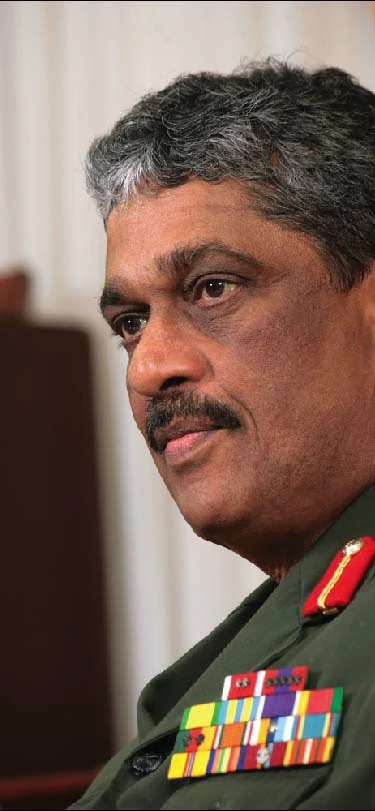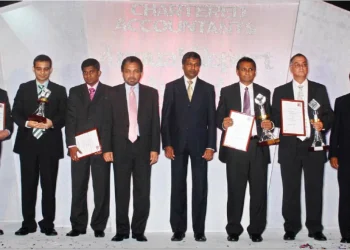
Politicians decide to wage battle, soldiers do the fighting. It takes skill, courage, determination and absolute conviction that victory is possible to fight an enemy. In this case, the enemy, the LTTE, was made out to be battle-hardened, resourceful and even invincible. A man who had fought in the trenches, led his troops from the front and was himself targeted by a suicide bomber, he thought otherwise. Lieutenant General Sarath Fonseka is single-minded and focused. He is aware of the challenges ahead and determined to finish what he started.
By Malinda Seneviratne
Photography By Sanka Sammana
It is widely acknowledged that the approach of engaging the LTTE took a decisive turn after Mahinda Rajapaksa became President. Could you outline the key differences in thinking and engagement that has led to the current success of the security forces?
Yes, there was a marked difference in assessment of the enemy, necessary preparations and also strategizing after President Rajapaksa came to power. He immediately appointed Gotabaya Rajapaksa as the Secretary, Ministry of Defence. I was appointed as Army Commander two weeks later.
This is not to say that we had failed miserably in earlier efforts of course. We scored limited successes though, and suffered equally bad reversals. It is natural for the blame to be laid at the door of politicians. It is they that decide to go to war after all, and so the praise or blame as the case may be accrues to them. However, we, who do the fighting, were not blameless either.
Overall, we didn’t handle the problem properly. This is why people thought that the LTTE was invincible and that Prabhakaran was a tactical genius. Both are false perceptions. Prabhakaran is just another terrorist. ‘Hit and run’ was his mode of operation. He had nothing to protect. Our mistake was that we gave him room to operate and allowed such perception to take root and indeed dominate the general political thinking.
Our politicians lacked determination. They were half-hearted for the most part, prone to complacency or defeatism. There were too many briefs, too many experts and too many advisors. It was difficult for politicians to take firm decisions. On the other hand, when decisions were made, we committed blunders, all three services did.
What was your battle-ground experience like?
I spent three years as a Battalion Commander, another three as Brigade Commander, three years as the Commander of a Division and three as a Security Forces Commander. I had considerable battle-ground experience. Wherever I served, in whatever capacity, I did my job. I never failed.
It is unfortunate that on occasions when we succeeded, others failed, thereby nullifying gains. We captured Mankulam in 1998 after fighting for 2 years, but later, under a different commander, Mankulam was abandoned in less than two hours.
In your opinion what was the fundamental flaw in the command structure of the security forces and especially the Army?
Well, the main problem was not putting the right man at the right place and the right time. It was all about service seniority and not about performance. We had high-ranking officers, but not all of them had the necessary commitment or proven skills.
There was also a sense that people were just going through the motions. No one seemed to want to finish this matter. In fact many expected me to follow suit, that is, hold this post, retire and then take up some diplomatic posting.
In All This, The Support And Wisdom Of The Secretary, Defence, Gotabhaya Rajapaksa Was Crucial. Together, We Looked Into The All Important Areas Of Arms And Ammunition, Weapons Systems Procurement, Strategy And Recruitment And Training.
What did you do differently?
I knew that the war will come, regardless of the CFA, regardless of sporadic rounds of negotiations. So, as the Jaffna Commander, I launched a training programme for the infantry. So, when I took over as Army Commander, I was ready with troops, training and tactics. On the ground, I deployed small teams into enemy territory, especially Special Forces teams.
In fact, in general, I went against the traditional thinking. I appointed junior officers who had battlefield experience to key commanding positions. For example, it is the No.5 officer in terms of seniority who is posted to the Jaffna Security Forces HQ. In this case, the person appointed was No. 15 in seniority. There was, naturally, a big hue and cry at the beginning, but as these officers began producing results, these complaints died down.
Similarly, some of the Division Commanders in the front are way down in the seniority list. Brigadier Shavindra Silva, for example, who spearheaded the capture of Pooneryn is the 45th in terms of seniority.
In all this, the support and wisdom of the Secretary, Defence, Gotabaya Rajapaksa was crucial. Together, we looked into the all important areas of arms and ammunition, weapons systems procurement, strategy and recruitment and training.
The Defence Secretary also knew that we would have to fight. At that time 40,000 soldiers didn’t have helmets. Many had just one uniform and one pair of boots. There was a shortage of 40,000 numbers of flak jackets. We needed to replenish stocks and get ready for a prolonged engagement with the enemy and this is exactly what we did.
We were lacking in strength of numbers as well. The battalions were depleted. I created five more divisions. And, as the people realised that something concrete was happening, that this time around there was commitment, capability and determination on the part of the political leadership as well as the security forces, the recruitment drive was extremely successful.
Earlier we would recruit approximately 3,000 per year, but now we are achieving targets of 3,000 per month. Immediately after we took Mavil Aru in August 2006, we managed to recruit 6,000 in a single month. In 2007, the total number of recruits was 32,000 and this year we have already recruited 34,000. The strength of the Army when I took over was 116,000. Today it stands at 170,000. So we have sufficient reserves now. I created 50 new battalions.
In fact this time around, it was the LTTE that was not ready. They were taken by surprise when they realised we were ready. Indeed, their strength has been depleted considerably. They started with 10,000 cadres and with new recruits the number went up to 15,000. They’ve lost around 12,000 fighters. Today they are left with just 2,500.
The huge human resource problem that the LTTE is facing is evident in the battlefield. We frequently come across teenagers, girls less than 15 years of age, and even Sea Tigers and intelligence operatives in the bunkers.
How about the general strategy in terms of battlefield operations?
We didn’t plan to nor were we interested in capturing a place and putting up a flag. That is the least important thing as far as we are concerned. At times the pace was slow, at times it was not. For five to six months last year, we proceeded only 7 kilometers. From April to November this year, we marched 60 kilometers. When we attacked and captured Mankulam in 1998 I was JOC. It took us 4 months to secure the place. This time Mankulam fell within four days.
We have come a long way from Mavil Aru. The map indicating areas controlled by Government forces and the LTTE keeps changing. What is the current situation?
As you know, we have routed the enemy on the Western Coast and are now pushing eastwards towards Mullaitivu. At the same time we have troops moving North on the Vavuniya and Welioya fronts. We had one Division and one Task Force operating from West of the A-9. Now we have 3 Task Forces in operation. Earlier we inducted a new division, which is operating from Welioya. On that front, they are now approximately 12 kilometers from Mullaitivu. In fact Mullaitivu is now within artillery range.
The LTTE, we were made to believe, was a formidable foe. It was said they possess a conventional fighting army and some even said that Colombo would be blown to pieces if the security forces dared attack the LTTE. Has there been any resistance?
Of course they resisted and they are still resisting. There is no way that 12,000 cadres can die if the LTTE was not resisting. It took two months to capture Malavi and Thunukkai. We were held up for two and a half months at Nachchikudah. As you may have heard, the LTTE has constructed a 17 km long bund South of Pooneryn and a similiar one west of Kilinochchi and Paranthan. There are booby traps, landmines and of course LTTE cadres for us to contend with.
We went looking for resistance. We didn’t look for easy gaps to penetrate enemy lines. We kept attacking and softening the targets. We know they are not going to hand anything over to us on a platter. Air Force operations were also very important in this. They engaged key depth targets. Navy killed over 300 Sea Tigers too.
As For Civilians, We Have Been Exemplary In Adhering To The Policy Of Zero Damage To Civilians.
There is the perception among certain circles that the LTTE has been adopting a strategy of tactical withdrawal. Your views?
This is nonsense. ‘Tactical withdrawal’ has never been the LTTE’s strategy. ‘Tactical withdrawal’, in that case, should have happened before they lost 12,000 men. Had they withdrawn from Pooneryn three months ago, they would have saved 1,000 lives. No, they are weak. The ideal time to attack was when we moved North on the Western front. They could have attacked our flank. They also had the option of launching an attack on Jaffna. Had they opted for this and succeeded, it would have been a serious situation. Now it is too late.
The LTTE’s policy has been one of recapturing. This is what they’ve always done. This is what they did at Sampoor when the CFA was in force. The LTTE never talked ‘tactical withdrawal’ to its cadres.
Of course some people believe that the LTTE will hit back, as they did in Mankulam. On the other hand, we know that history and we will not allow repetition.
Has it been a one-way street though? How about losses on the side of the security forces?
The LTTE has experienced and skilled fighting cadres and therefore yes, we have suffered losses as well. About 500 of our men have lost their legs to anti-personnel mines. Every inch of the way has been booby trapped. We have recovered some 500,000 mines so far. It has certainly not been a cake walk. Who should we blame for this, if not those who gave the LTTE the hardware, those who made it possible for them to bring in the hardware?
As of now, few would argue against the need to eliminate the LTTE militarily. On the other hand, there is the question of civilians, trapped in the Wanni and used as a human shield by the LTTE. How do you negotiate around this problem?
Well, in no military engagement can you absolutely avoid collateral damage. We cannot avoid destruction of property, for example. However, everything that is damaged will be rebuilt. This is the strategy adopted in the East and it has succeeded. On the other hand, contrary to the claims made by those who pumped in a lot of money to the Wanni, there’s absolutely no ‘development’ to be seen in these areas we have liberated in the past few months. The NGOs and INGOs had done nothing in the East. They have done nothing West of the A-9 highway in the North.
As for civilians, we have been exemplary in adhering to the policy of Zero Damage to Civilians. There were 17 civilians who died in the East when a rocket hit a refugee camp that the LTTE had re-located so it was next to an LTTE facility.
In the North, there have been two incidents only. In Mullaitivu a coconut estate controlled by the LTTE leader Swarnam was attacked. One man and a child had died in this attack. Also, west of the A-9 and South of Kilinochchi 4-5 children have been reported killed. In the second incident it was found that they had done fatigue work for the LTTE.
Thus, we have 24 civilians confirmed killed after two and a half years. All things considered, this itself indicates that the security forces have done their utmost to minimize damage to the civilians trapped in the Wanni. After the LTTE abandoned their entry/exit point in Omanthai, some 400 civilians have managed to cross over to Government controlled areas. These numbers will increase in the coming weeks and months.
This doesn’t mean that everything is going to be easy, let me add. The LTTE had 4 years to stockpile arms and ammunition during the time the CFA was in operation. They still have a lot of money. They will fight. But we are ready.
There Was Another Attempt At Negotiations In 2006. Again, No Results. We Didn’t Achieve Anything, But The Tigers Got Stronger. They Developed A Police Force, Build Runways, Secured Airpower And Developed The Sea Tigers Outfit.
The East was cleared, but there is an alarming LTTE presence there, with a series of killings happening over the past few weeks. What’s the situation?
This is true. There is a group operating. But they can’t last. We are not and will not overreact. Small groups do try to come through our defences, many get killed, some get injured and a few manage to evade us. However, they don’t have the back up necessary to continue for long periods of time. They have to beg for food and medicine. Some hand themselves over. Once the land route is sealed, we can expect this to end.
The LTTE has essentially lost the support of ordinary Tamil civilians. There was a trade fair in Jaffna the same day that Balaraj died. He was a top LTTE leader and a popular personality as well. We expected a low turn out for the fair, but 50,000 people came. When we captured Pooneryn, there were celebrations in Jaffna. There were 1,000 three wheelers in that procession. And their slogan, significantly, was ‘Prabhakaran, release the innocent civilians in the Wanni’. We were naturally surprised. The truth is that infiltrators no longer have safe houses in Jaffna. The civilians give us information. They have essentially lost confidence and faith in the LTTE. The LTTE has lost all credibility as a group claiming to represent Tamil people.
You said that one of the key reasons for this success is the political leadership and its determination. Are you saying that if tomorrow there is a different administration with a different approach, all this could be reversed?
Like any country, Sri Lanka must have a national security plan. If the people elect a weak leader, one who underestimates our ability and overestimates the strength and capabilities of the enemy, we will lose territory and the problem will get worse. Such a person can be a leader but is definitely not a patriot. So yes, things can change. National security will go for a six.
Whoever says ‘stop the offensive and go for a CFA better look back at what happened during the last CFA. At that time the LTTE had two 120 motar and two 122m guns. Four years into the CFA they had 80 120mm motars and 22 122m guns, 3 130mm guns and a 152m gun and of course correspondingly large amount of ammunition.
In 2002 they had 4,000 cadres. By 2006 they had 12,000. During this same period, there weren’t deaths, yes, but in four years another army came into being. There were several rounds of talks between 2002 and 2004, but nothing came out of these discussions. There was another attempt at negotiations in 2006. Again, no results. We didn’t achieve anything, but the Tigers got stronger. They developed a police force, built runways, secured airpower and developed the Sea Tigers outfit.
Such people, sad to say, don’t mind the security forces suffering setbacks as long as it also means the President is weakened and their political objectives are secured. They celebrate setbacks and are upset when the security forces score any significant victory over the LTTE. In fact, it seems that they wouldn’t mind if Prabhakaran became President of this country.
I think, like in other countries, national security should not change, even if governments change. The President has to be a patriot. We have to live with pride and honour and this need has to be recognized by whoever is in power.
Presidents and politicians, they come and go. But citizens remain. They need security. They want a country, they want a future, for themselves and their children.
There was an opinion expressed that the capture of Pooneryn was timed to coincide with the vote for the Second Reading of the Budget. Is there any truth in this conjecture?
No. Our strategy is directed towards eliminating terrorists and not to put up a flag or become part of political games. It is the realities of the ground situation that determine military strategy. I can’t win the confidence of my fighting cadres if I let political imperatives dictate battlefield decisions. If I did that I will lose my soldiers. No one told me to capture Pooneryn on such and such a date and no one expects me to do so either. This is a serious matter and we can’t be playing games with our soldiers and our national security concerns.
In this regard I can also refer to the time of the last budget. At the time we suffered a setback in Muhamalai. No one charged us of engaging in a conspiracy to bring down the government then.
War is no doubt a political decision. The credit goes to the political masters, that is, the Government. The timing of a particular success is a different matter, though. These are processes that are independent of one another in this case. We have been tasked with fighting an enemy, eliminating a terrorist, and not buttressing a political party or a Government. Whether what we do on the ground has an impact on political affairs is a different matter. We don’t concern ourselves with such things.
The President Has To Be A Patriot. We Have To Live With Pride And Honour And This Need Has To Be Recognised By Whoever Is In Power.
How has the business community responded to your efforts?
Tremendously. They appreciate the sacrifices of the security forces and have contributed generously to the welfare of our fighting men and women, especially the housing project. They want to see an end to this, naturally. For a long time, they were asked to believe that the LTTE could not be defeated and that some accommodation must be made. However, now the business community, like most other people have realized that negotiation is not possible with the LTTE and therefore we need to finish this off and that we need to come together in this critical moment.
Finally, a word about NGOs and INGOs and ‘humanitarian concerns’ they articulate frequently…?
It is easy to make a song and dance when you don’t know what you are talking about or know nothing of the ground reality. For example, the suicide cadre who blew up the bus in Fort had been reported ‘missing’ to the ICRC by his mother. People need to have a sense of proportion. I am not saying that all NGOs and INGOs are in cahoots with the LTTE. That’s not necessarily true. The truth is that very little if at all has been done in the North by NGOs and INGOs, a situation which would naturally make anyone suspicious about what they were actually doing in these areas with their money, their personnel, their equipment, vehicles and other machinery.
The ICRC performs a very important role. Medicines Sans Frontiers does some good work and I am aware of this. But the majority of INGOs and NGOs have not done anything constructive. They’ve mollycoddled the LTTE, have not acted in the national interest and the authorities should take serious note about all this. We are aware that some actually left equipment with the LTTE. The bottom line is this: if you can’t deliver, then leave!’
PROFILE– LIEUTENANT GENERAL G S C FONSEKA RWP, RSP, VSV, USP, rcds, psc has been appointed the Commander of the Army in Sri Lanka effective from 6th December 2005. Widely admired as one of the top battle-hardened warriors of our times, Lieutenant General G S C Fonseka has served largely as an illustrious infantry soldier in the northern theatre of war during his exemplary career, particularly at the peak of Tamil Tiger terrorism. When the Jaffna Fort was under siege for a long period, then Colonel G S C Fonseka led troops in the famous “Midnight Express” operation to rescue troops. He was the Deputy General Officer Commanding that launched ‘Operation Riviresa’ to evict terrorists and capture Jaffna town in December 1995. His dynamic leadership, meticulous planning and extensive tactical knowledge in this and other operations were also in evidence during ‘Operation Unceasing Waves’ in 2000 which further consolidated the security network to Jaffna during his four-month stint as Commander, Security Forces Headquarters, Jaffna. Lt General Fonseka, as a fearless infantryman was at the forefront in operations ‘Balawegaya’ and ‘Jayasikuru,’ that led to the rescue the Elephant Pass and capture of Mankulam. Lt General Fonseka, who distinguished himself by his dauntless bravery and excellent command in warfare as well as for his common touch with his troops, sustained injuries during the operation ‘Yaldevi’. Jaffna finally became his second home during the period May 2002-November 2003 after he was reappointed as the Commander, Security Forces Headquarters, Jaffna. His awards and decorations include the Gallantry Medals, Rana Wickrema Padakkama (RWP), Rana Sura Padakkama (RSP), Vishishta Seva Vibhushana (VSV). Utthama Seva Padakkama (USP), Riviresa Campaign Service Medal, Poorna Bhoomi Padakkama, North & East Operations Medal, Desha Puthra Sammanaya and several others. He served as Deputy Chief of Staff, Sri Lanka Army (July 1, 2004 – December 9, 2004), Director General Infantry, Army Headquarters and later on commanded the Sri Lanka Army Volunteer Force between November 23, 2003 and August 15, 2004. In recognition of his fearless leadership, he was twice appointed the Commander, Security Forces Headquarters, Jaffna (April 21 – July 21, 2000) and (May 5, 2002 to November 23, 2003). Enlisting in the Army on February 5, 1970, he was commissioned as a 2nd Lieutenant and subsequently posted to the 1st Battalion, Sri Lanka Sinha Regiment on June 1, 1971. He has followed the UK-based course offered by Royal College of Defence Studies, Infantry Officers Advanced Course (USA), Staff College Course (Bangladesh), Company Commanders Course (Pakistan), Battalion Support Weapons Course (India), Counter Insurgency Jungle Warfare Course (India), Commando Officers Course (India) and has represented Sri Lanka in a number of international seminars and conferences. Lt General Fonseka, a product of Ambalangoda Dharmasoka College (1958-1965) and Ananda College, Colombo (1966-1969) is a keen sportsman who has excelled in swimming and water polo representing defence services and the country.





